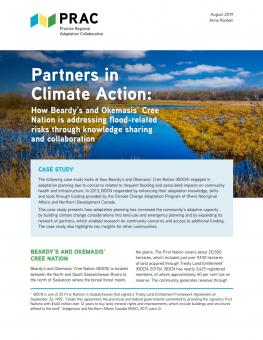
Partners in Climate Action: How Beardy's and Okemasis' Cree Nation is addressing flood-related risks through knowledge sharing and collaboration
This case study outlines Beardy’s and Okemasis’ Cree Nation’s climate change adaptation planning process and the tool that supported it, the Pathways to Climate Change Resilience Guidebook.
Key Messages
- By undertaking an adaptation planning process guided by the Pathways to Climate Change Resilience Guidebook, Beardy’s and Okemasis’ Cree Nation in Saskatchewan has gained a better understanding of climate-related risks and opportunities and has prioritized adaptation actions based on local climate projections.
- Validating past climate and current changes using Traditional Knowledge was a powerful way to engage community members in adaptation initiatives and ongoing monitoring.
- Establishing a wide network of partners helped Beardy’s and Okemasis’ Cree Nation access the tools, resources and information required to demonstrate the shortcomings of existing infrastructure and resulting impacts on community members, leading to funding and support for longer-term solutions.
First Nations communities are increasingly becoming concerned about the risks posed by climate change, such as impacts from more frequent and extreme flooding events. For the area between the North and South Saskatchewan Rivers, where Beardy’s and Okemasis’ Cree Nation is located, climate projections anticipate greater variability in precipitation, warmer winters, more frequent windstorms and longer periods of extreme heat. These changes underscore the need for communities to prepare.
Beardy’s and Okemasis’ Cree Nation undertook an adaptation planning process to identify key risks and vulnerabilities as well as to prioritize adaptation actions following repeat flooding in 2005, 2007 and 2011 that damaged infrastructure and created health and safety concerns. They used the Pathways to Climate Change Resilience Guidebook to guide this process. The Pathways to Climate Change Resilience Guidebook is designed to help rural Canadian forest-based communities undertake climate change adaptation planning. It is a trail map of how small communities can learn more about climate change and identify what its impacts might be in their unique geographic, social, cultural and economic situations.
Following a community meeting, the chief, a councillor, several band staff members and other community members identified, assessed and evaluated climate-related risks and opportunities and created a ranked list of actions. Adaptation planning has led Beardy’s and Okemasis’ Cree Nation to implement a number of actions, including drinking water quality research in partnership with the University of Saskatchewan and the Saskatchewan Research Council, and installation of an expanded drainage ditch with larger culverts to secure community road access and prevent future flooding. This case study presents the process used by Beardy’s and Okemasis’ Cree Nation and highlights key insights for other communities.
You might also be interested in
A Case for Adaptation: Preparing for Climate Disasters in Manitoba
Recent catastrophic events across the Prairies have given scientists reasons to believe more frequent, extreme events like floods, forest fires, and storms are the most immediate climate risk threatening these areas.
ClimateWest launches to support adaptation to climate change on the prairies
A changing climate will have a significant impact on the Canadian prairies and there is a need for more proactive adaptation and resilience planning.
From Flooding to Fire: How the Town of Canmore is preparing for climate change
This case study outlines the Town of Canmore's climate change adaptation planning process and the tool that supported it, the Climate Resilience Express tool.
How Can We Work With Nature to Tackle Drought and Desertification?
Drought is one of the most devastating and pervasive challenges exacerbated by climate change. However, we can work to reduce its effects through nature-based solutions for land restoration and climate-smart agriculture.